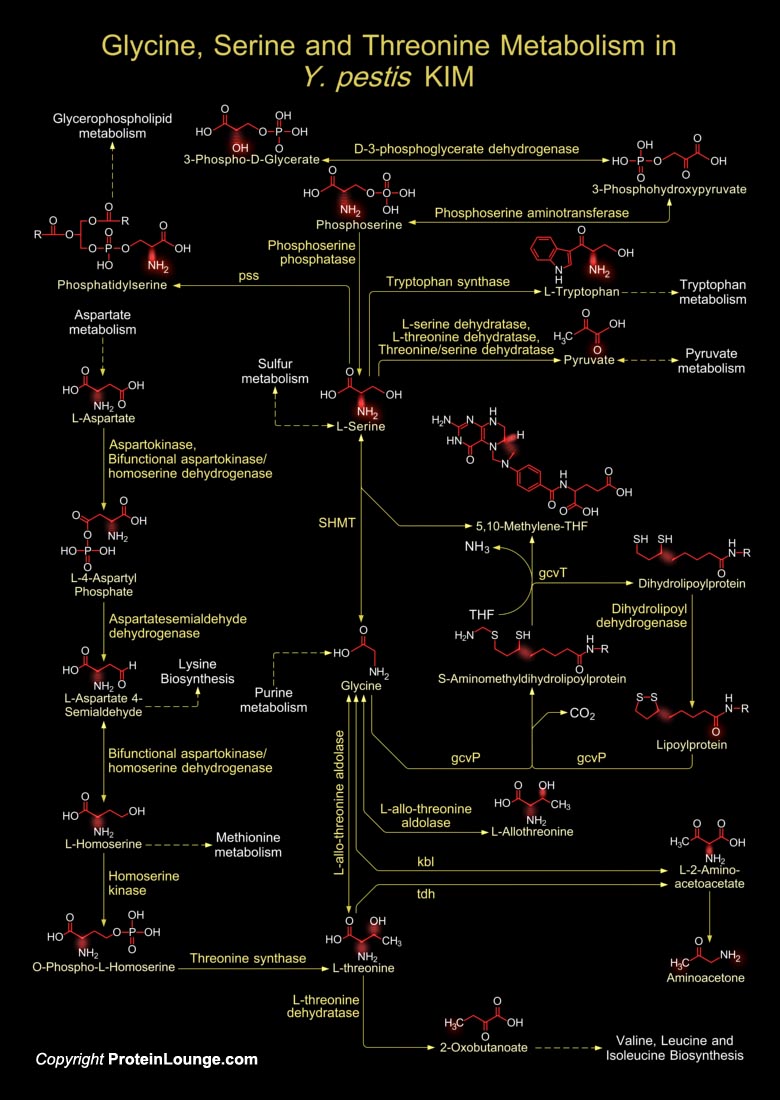
Y. pestis (Yersinia pestis) strand KIM belongs to biovar Mediaevalis. Y. pestis is actually catagorized into three subtypes or biovars; Antiqua, Medievalis, and Orientalis, each associated with a major pandemic and it is believed that Y. pestis is a clone that evolved from Y. pseudotuberculosis (Yersinia pseudotuberculosis) about 1.5 to 20 thousand years ago. Biovar Mediaevalis is thought to have descended from the bacteria that caused the second pandemic, the Black Death. The Black Death came in three forms, the bubonic, pneumonic, and septicemic. Each different form of plague killed people in a vicious way. All forms were caused by a bacterium called Y. pestis. This Coccobacillus is rod shaped, Gram-negative, and non-motile but has two distinct flagellar gene[..]
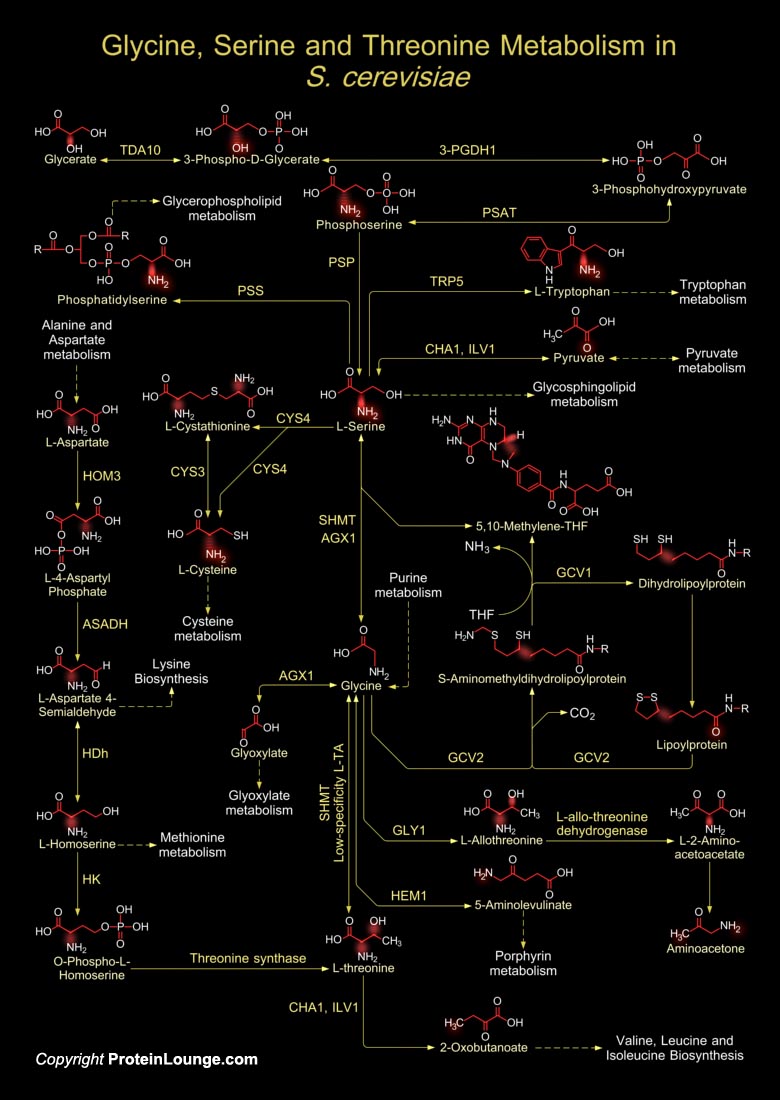
S. cerevisiae (Saccharomyces cerevisiae) are single-celled fungi which multiply by budding or in some cases by division (fission). Yeast fermentations comprise the oldest and largest application of microbial technology. Yeast physiology can be either obligately aerobic or facultatively fermentative. There is no known obligately anaerobic yeast. In pharmacy and chemistry, a large number of substances (Vitamins and enzymes) are extracted from this organism. In addition, some medications are now produced by manipulated yeasts, for example vaccines against Hepatitis-B surface antigen are produced by S. cerevisiae utilizing recombinant technology. The metabolism of Glycine, Serine and Threonine in S. cerevisiae is of vital importance as they use L-Serine or L-Threonine as[..]
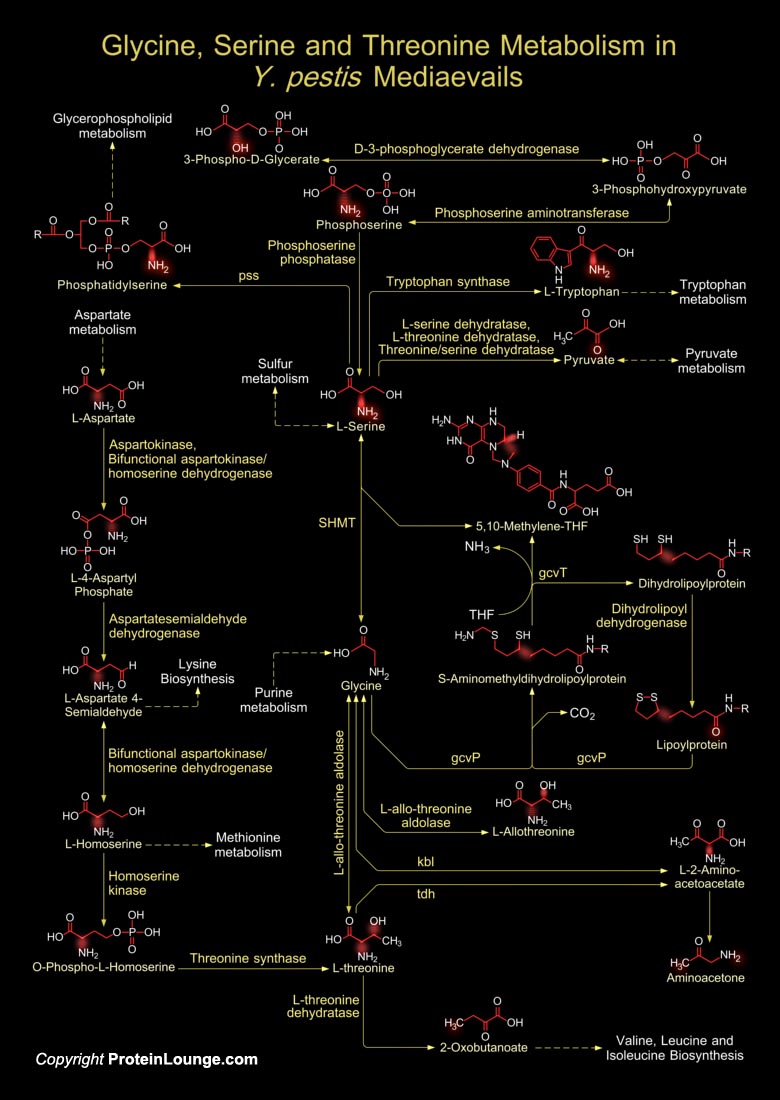
Y. pestis (Yersinia pestis) is rod shaped, Gram-negative, and non-motile but has two distinct flagellar gene clusters; one set is incomplete and the other produces a truncated protein, which acts as a transcriptional activator for the flagellar genes. Y. pestis, a Group-A bioterrorism agent, causes Plague, a re-emerging zoonotic disease transmitted to humans through flea bites and typically characterized by the appearance of a tender and swollen lymph node, the bubo. It is believed that Y. pestis is a clone that evolved from Y. pseudotuberculosis (Yersinia pseudotuberculosis) about 1.5 to 20 thousand years ago. Y. pestis is primarily a rodent pathogen, with humans being an accidental host when bitten by an infected rat flea (Ref.1). The rodents’ fleas, such as[..]
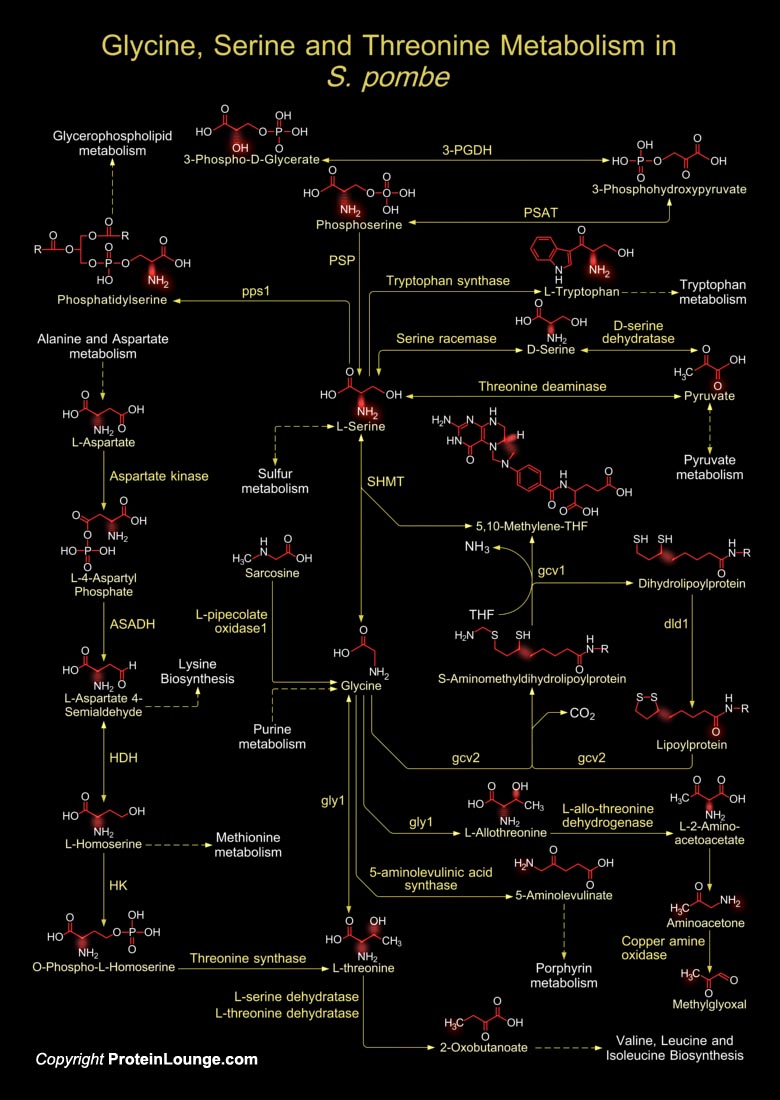
The metabolism of Glycine, Serine and Threonine is essential for the unicellular eukaryote S. pombe (Schizosaccharomyces pombe), as it uses L-Serine or L-Threonine as sole nitrogen source for its survival. During the metabolism of these amino acids, L-Threonine is generally synthesized from Pyruvate and L-Aspartate. The enzyme Threonine Ammonia Lyase/Threonine Dehydratase converts Pyruvate (from Pyruvate metabolism) to amino acids like L-Serine. Serine Hydroxymethyltransferase/Glycine Hydroxymethyltransferase then catalyzes the THF (Tetrahydrofolate) dependent cleavage of L-Serine to Glycine and 5,10-Methylene-THF (5,10-Methylenetetrahydrofolate). Serine Hydroxymethyltransferase is the major provider of one-carbon units in the cell, which are derived from catabolism of[..]
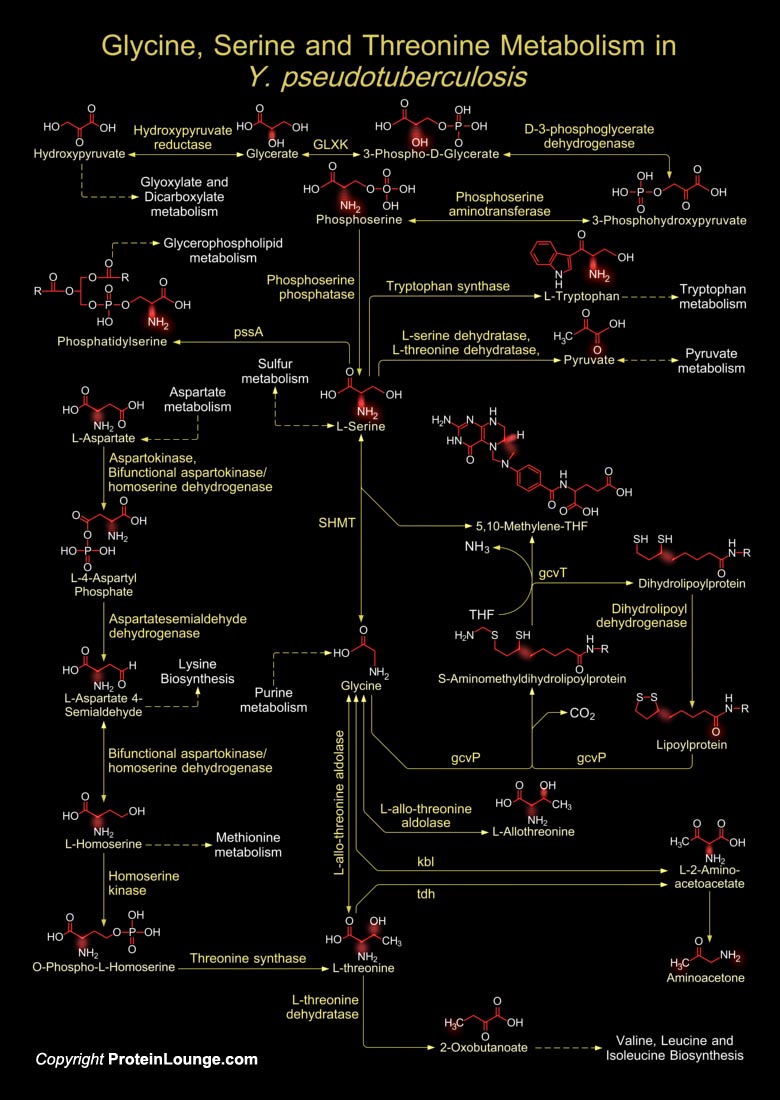
The genus Yersinia is known to include eleven species, three of which are potentially pathogenic to humans; Y. pestis (Yersinia pestis), Y. pseudotuberculosis (Yersinia pseudotuberculosis), and Y. enterocolitica (Yersinia enterocolitica). Y. pseudotuberculosis is a Gram-negative Coccobacillus belonging to the family Enterobacteriaceae. The designation pseudotuberculosis derives from the characteristic histopathological aspect occurring in mesenteric lymph nodes of Lymphoid Hyperplasia cases which closely resemble those observed during tuberculosis infection (Ref.1). Y. pseudotuberculosis is widely spread in the environment (soil, water, vegetables, etc). This bacterium is a primary pathogen of wild and domestic animals in all continents. Nearly all animal species are[..]
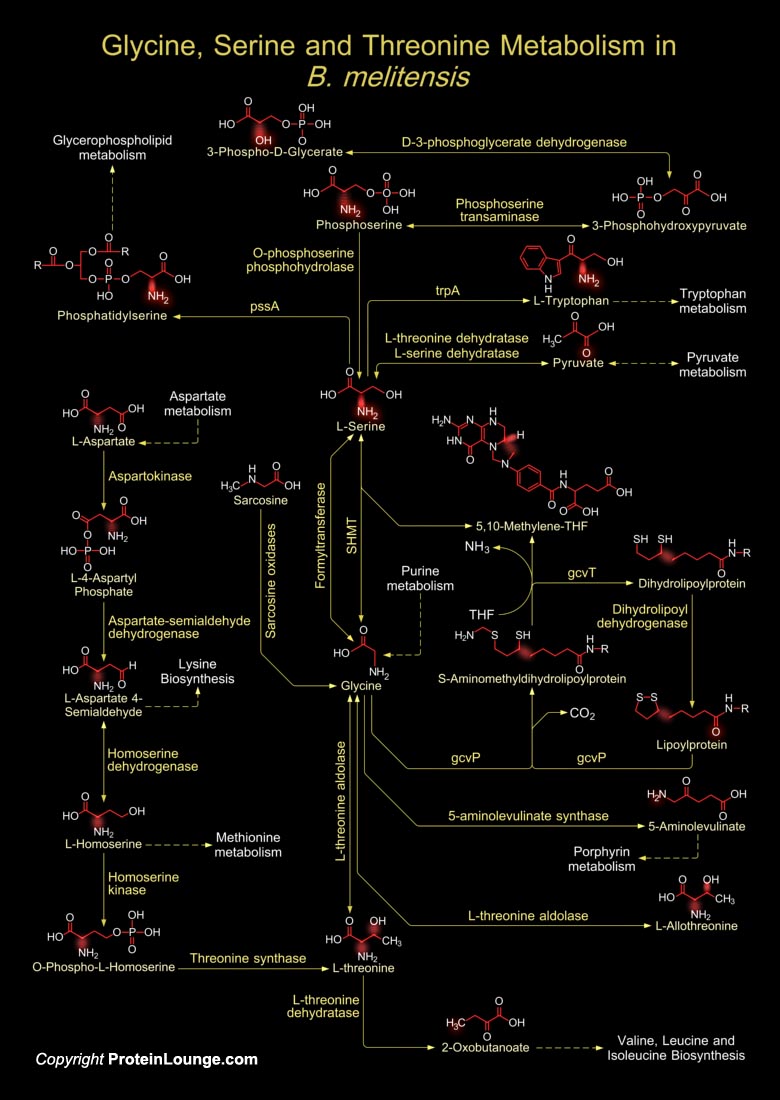
B. melitensis (Brucella melitensis) is a Gram-negative, aerobic, facultative intracellular bacterial pathogen that causes abortion in goats and sheep and Malta fever in humans. Species in the genus Brucella are the etiological agents of Brucellosis, a zoonotic disease endemic in many areas of the world, characterized by chronic infections in animals leading to abortion and infertility, and a systemic, febrile illness in humans. Brucella is facultative intracellular pathogens that enter the host through mucosal surfaces and are able to survive inside macrophages (Ref.1 & 2). The presence of S-LPS (Smooth Lipopolysaccharide) is an important virulence factor of these organisms. The role of the O-side chain or O-antigen of S-LPS in the survival of Brucella has not been[..]
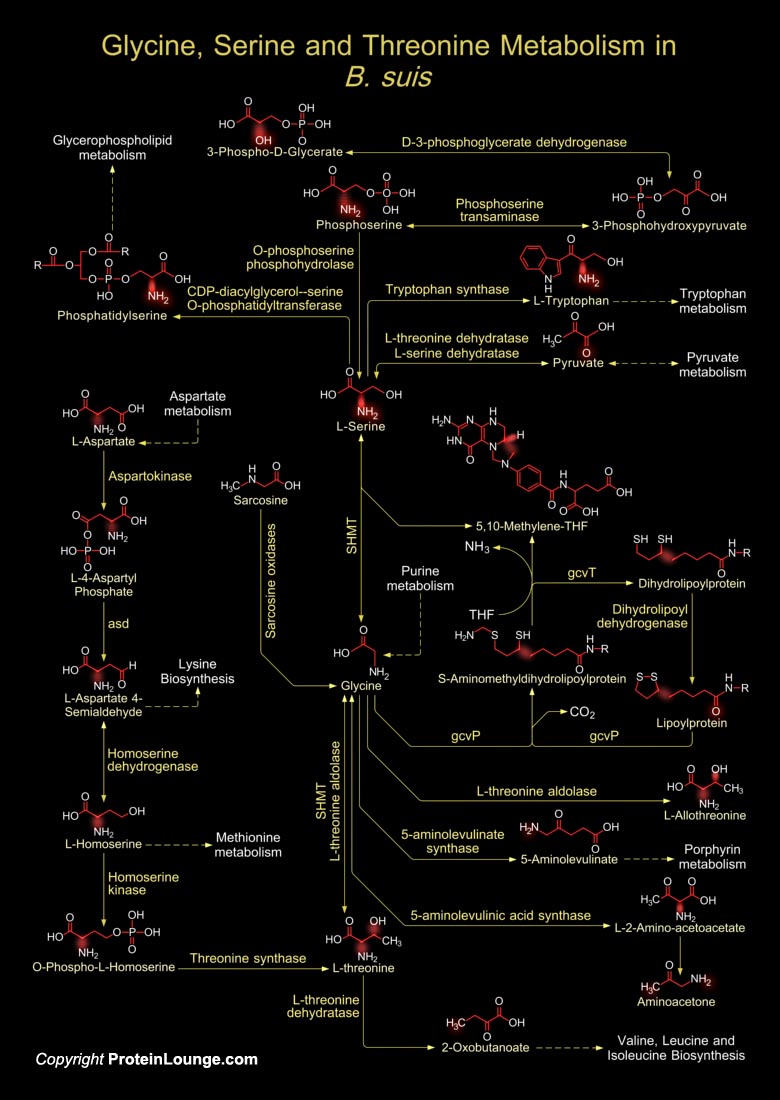
Species in the genus Brucella are the etiological agents of Brucellosis, a zoonotic disease endemic in many areas of the world, characterized by chronic infections in animals leading to abortion and infertility, and a systemic, febrile illness in humans. Brucella is facultative intracellular pathogens that enter the host through mucosal surfaces and are able to survive inside macrophages. B. suis (Brucella suis) is the first Gram-negative pathogenic organism weaponized as a potential bioterrorism agent (Ref.1). The presence of S-LPS (Smooth Lipopolysaccharide) is an important virulence factor of these organisms. The role of the O-side chain or O-antigen of S-LPS in the survival of Brucella has not been clearly defined; however it might provide a protective mechanism in[..]
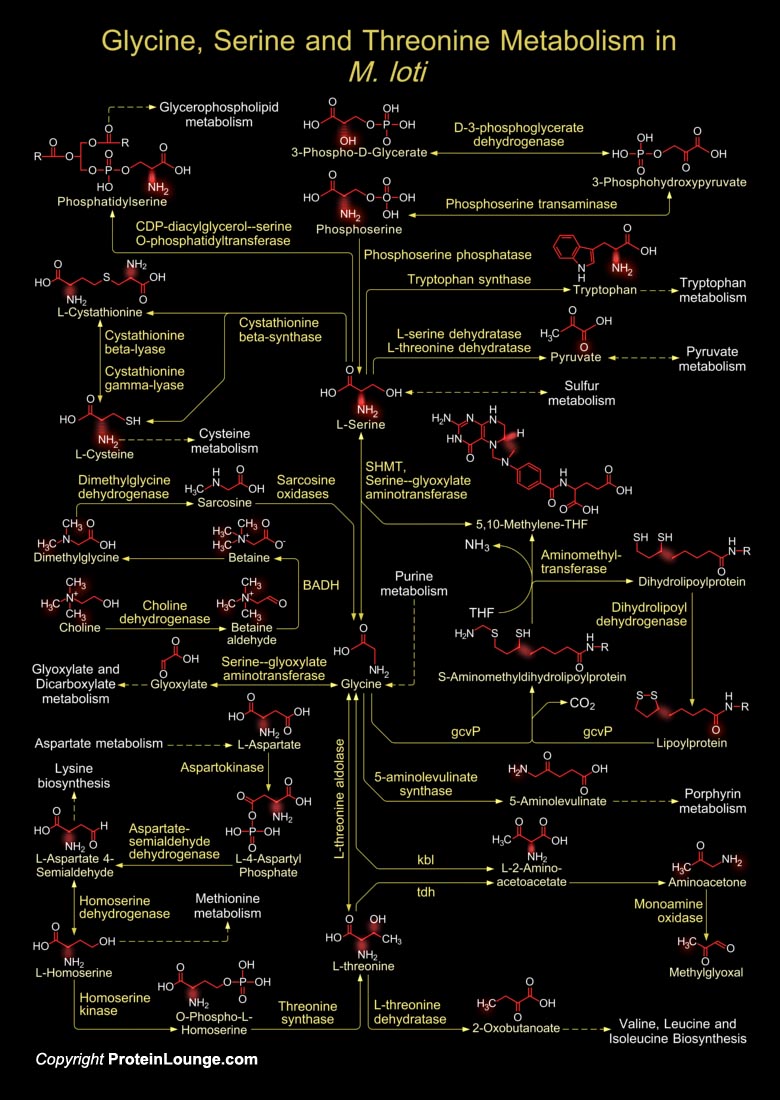
Rhizobium, Bradyrhizobium, Mesorhizobium, Sinorhizobium, and Azorhizobium-collectively known as rhizobia, are Gram-negative, nitrogen-fixing bacteria of agronomic importance because they perform nitrogen-fixing symbioses with leguminous plants (soybean, alfalfa, beans, peas, etc). The metabolism of amino acids like Glycine is indispensable for functioning of one-carbon metabolism and for the establishment of a fully effective, nitrogen-fixing root nodule symbiosis in M. loti (Mesorhizobium loti). Glycine acts as a source of other vital amino acids like L-Serine and L-Threonine. It also contributes to the one-carbon pool, to formation of Glutathione, to Purine nucleotides, and to Porphyrins. Purine Metabolism may also form a source of Glycine. Direct routes of Glycine[..]
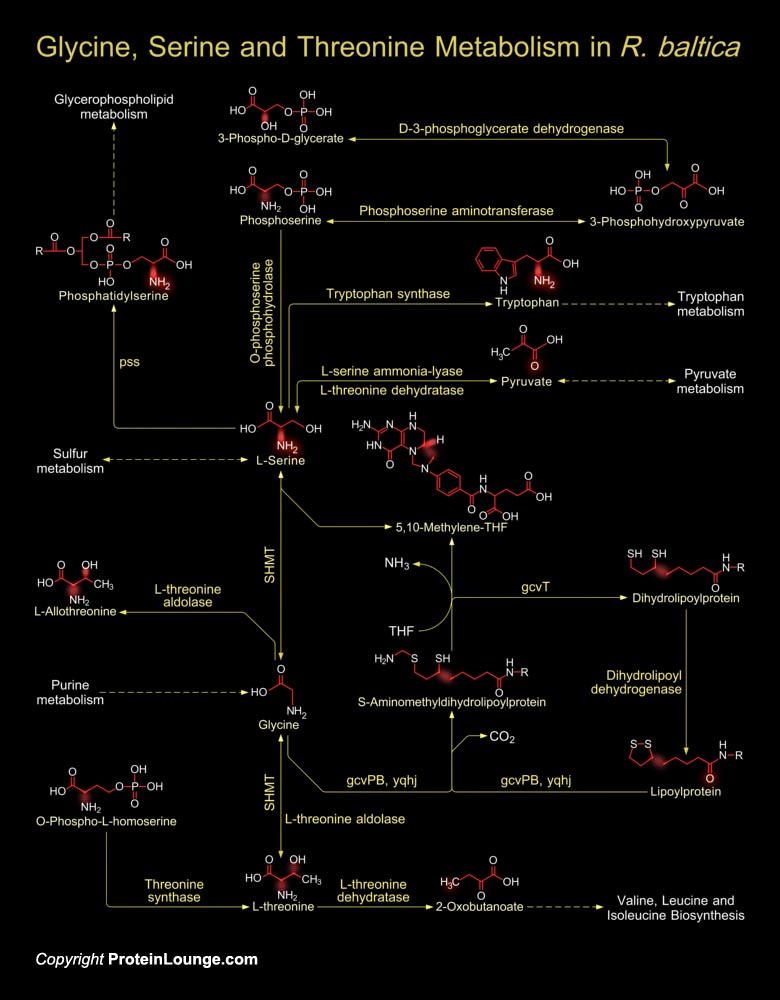
R. baltica (Rhodopirellula baltica) is a marine, aerobic, heterotrophic representative of the globally distributed and environmentally important bacterial order Planctomycetales. They catalyze important transformations in global carbon and nitrogen cycles. From a phylogenetic perspective the order Planctomycetales forms an independent, monophyletic phylum of the domain Bacteria. These are thought to be the deepest branching bacterial phylum. Planctomycetes are unique in many other respects. Their cell walls do not contain peptidoglycan, the main structural polymer of most members of the domain Bacteria. They show a unique cell compartmentalization in which a single membrane separates a peripheral ribosome-free paryphoplasm from the inner riboplasm (pirellulosome).[..]
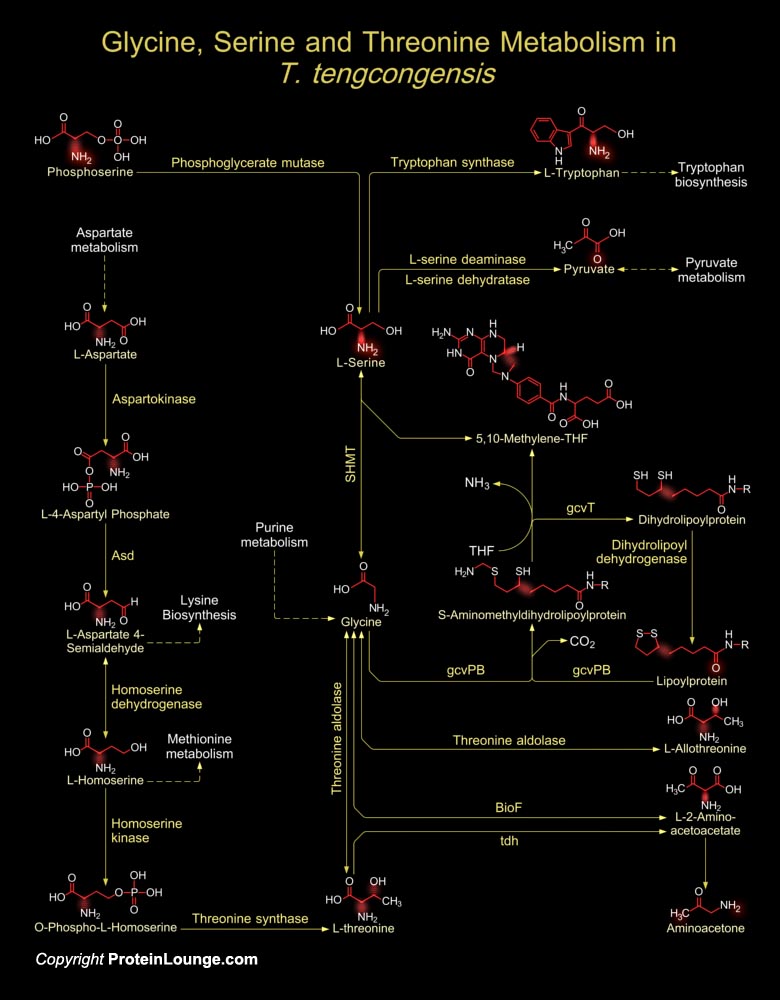
T. tengcongensis (Thermoanaerobacter tengcongensis) is a rod-shaped, Gram-negative, anaerobic eubacterium that metabolizes sugars as the principal source of energy and carbon source, and gains energy anaerobically by Sulfur respiration. T. tengcongensis has a complete collection of genes involved in most of the amino acid biosynthetic pathways for Threonine, Valine, Leucine, Histidine, Phenylalanine/Tyrosine, Tryptophan, Arginine and Methionine. However, it lacks a few key genes such as Threonine Dehydratase for Isoleucine biosynthesis and Ornithine Cyclodeaminase for Proline biosynthesis. For nucleotide metabolism, it also has a complete set of genes for Purine biosynthesis, Purine salvage, and Pyrimidine biosynthesis pathways (Ref.1). In the direction of L-Threonine[..]
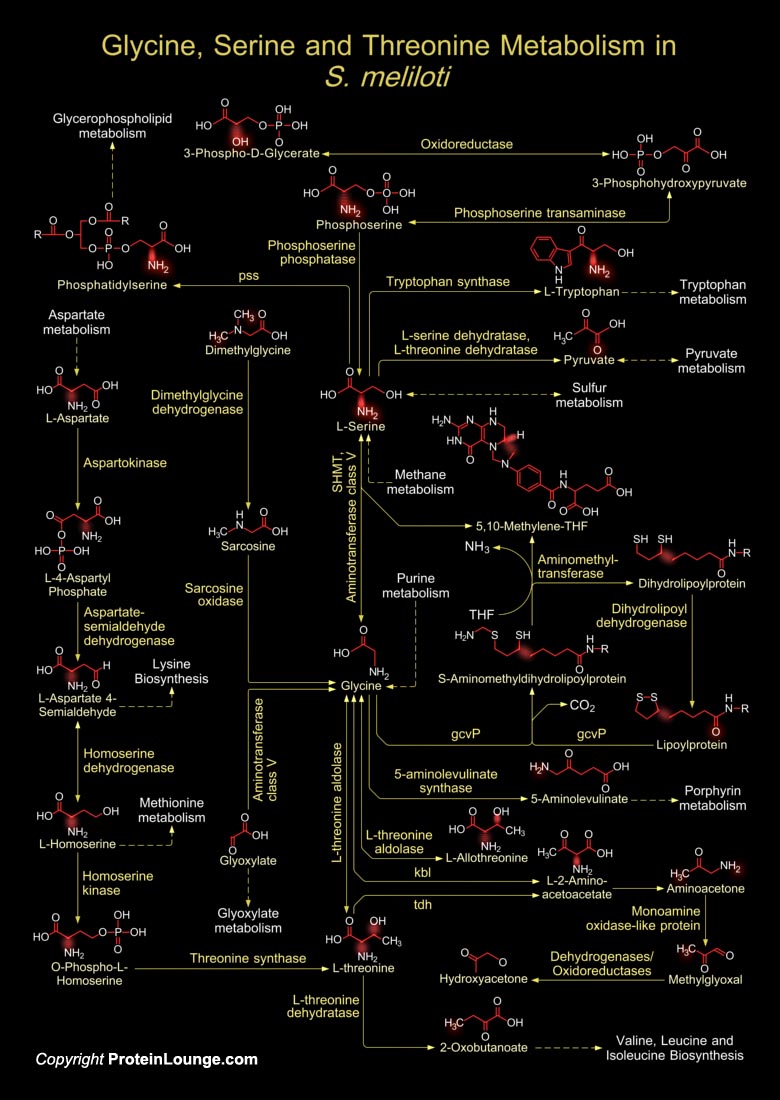
One of the most interesting and perhaps best-studied plant bacterial interactions is between rhizobial species and economically important leguminous plants (soybean, alfalfa, beans, peas, etc.). Rhizobia are generally described as root-nodule-forming nitrogen-fixing symbionts belonging to one of five species, Rhizobium, Bradyrhizobium, Sinorhizobium, Azorhizobium, and Mesorhizobium. The S. meliloti (Sinorhizobium meliloti) genome consists of a circular chromosome and two large circular elements (mega plasmids), one of which is essential for growth and Quorum-sensing (Ref.1 & 2). In this Gram-negative bacterium the metabolism of amino acids like Glycine is indispensable for functioning of one-carbon metabolism and for the establishment of a fully effective,[..]
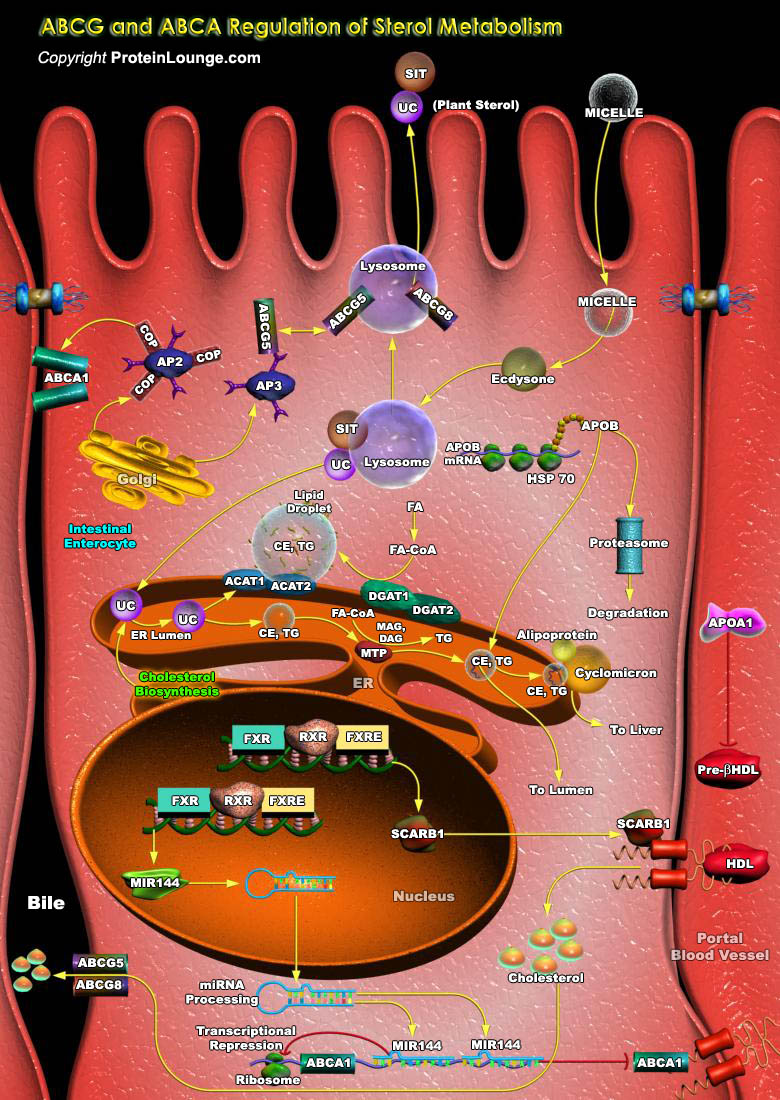
ATP Binding Cassette transporters comprise a large family of membrane-spanning proteins that are responsible for transporting a variety of substrates in prokaryotes and eukaryotes. The most intriguing and, arguably, the most important membrane proteins for this purpose are the ABC (ATP-Binding Cassette) transporters. These proteins, found in all species, use the energy of ATP hydrolysis to translocate specific substrates across cellular membranes. Many of these transporters are responsible for the translocation of lipophilic substrates such as phospholipids, bile acids, and sterols (Ref.1 & 2).Beta-Sitosterol and other plant sterols are directly transported back to the gut lumen by the heterodimeric ABCG5-ABCG8 complex by means of a sort of kickback mechanism, which[..]

